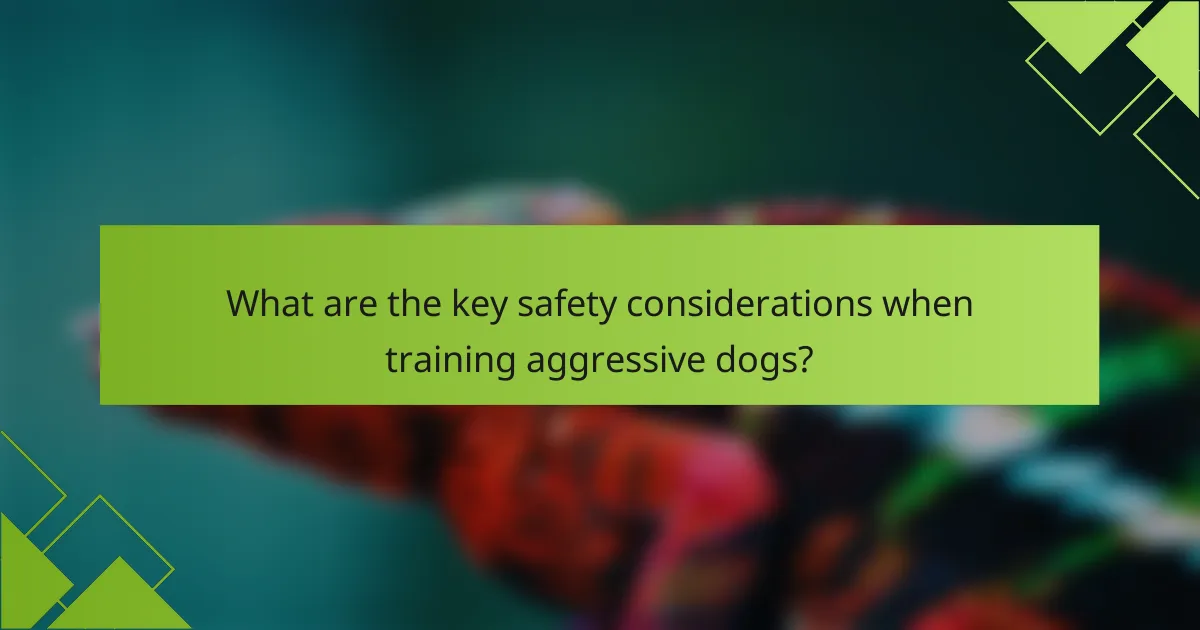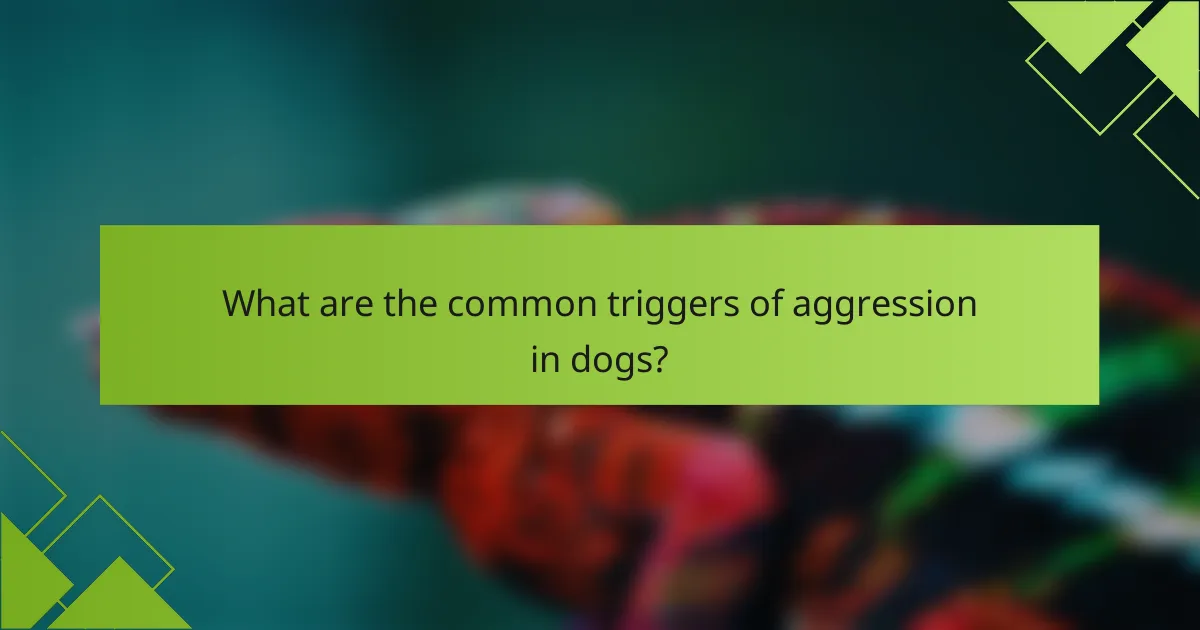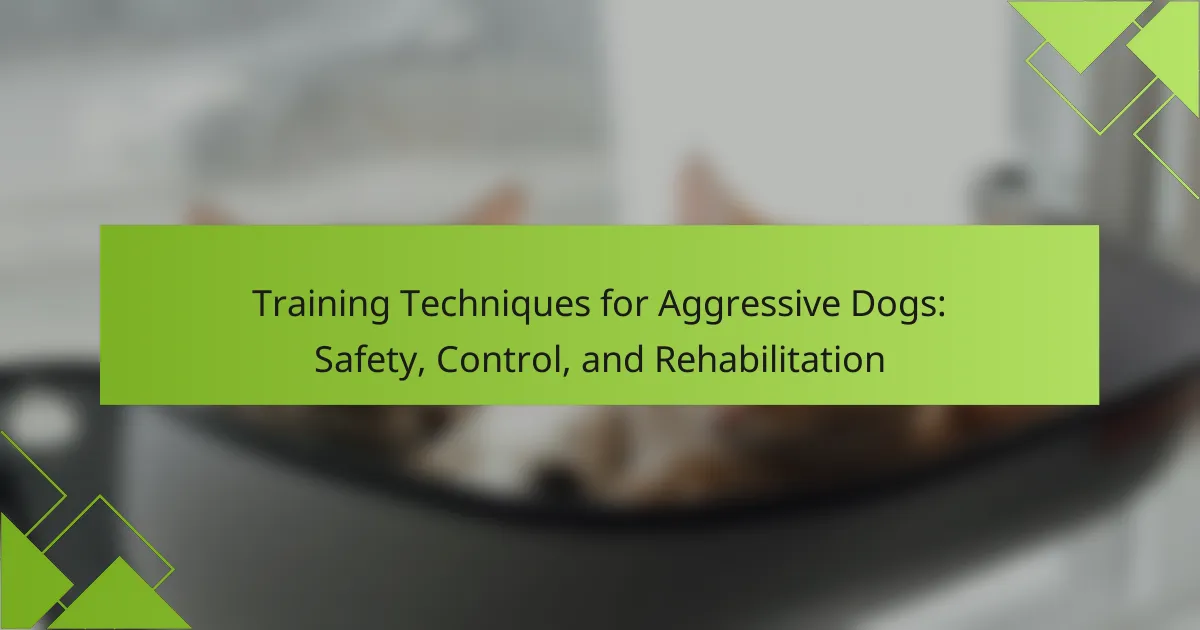Training aggressive dogs requires a strategic approach to ensure safety and effective rehabilitation. Key considerations include understanding triggers, implementing control techniques, and utilizing positive reinforcement. Socialization plays a vital role in reducing fear-based aggression, while consistent monitoring of progress helps tailor training methods. Engaging with a professional trainer can provide additional support and specialized strategies for managing aggressive behavior.

What are the key safety considerations when training aggressive dogs?
Key safety considerations when training aggressive dogs include using controlled environments, employing positive reinforcement, and ensuring handler safety. Always assess the dog’s triggers and body language to prevent escalation. Utilize appropriate equipment, such as muzzles or leashes, to maintain control during training sessions. Gradually introduce new stimuli to reduce anxiety and aggression, ensuring a safe space for both the dog and trainer.
How can understanding canine body language improve safety during training?
Understanding canine body language enhances safety during training by allowing trainers to recognize signs of stress or aggression. This awareness enables timely interventions, reducing the risk of incidents. For example, identifying a dog’s raised hackles or bared teeth can signal discomfort, prompting a change in approach. Additionally, understanding these signals fosters a more positive training environment, improving the dog’s response and overall success in rehabilitation. Recognizing these unique attributes of canine communication is essential for effective and safe training practices.
What equipment is essential for safely training aggressive dogs?
Essential equipment for safely training aggressive dogs includes a sturdy leash, a well-fitted muzzle, a harness, high-value treats, and training clickers. These tools enhance control and ensure safety during training sessions.
1. Sturdy leash: Provides control and prevents sudden movements.
2. Well-fitted muzzle: Ensures safety for both the dog and others.
3. Harness: Distributes pressure evenly and reduces strain.
4. High-value treats: Motivates the dog during training.
5. Training clickers: Aids in precise communication of desired behaviors.
Why is socialization critical for aggressive dogs?
Socialization is critical for aggressive dogs as it helps reduce fear and anxiety, promoting positive behavior. Proper socialization exposes dogs to various environments, people, and other animals, fostering adaptability and confidence. This process aids in controlling aggressive tendencies by teaching appropriate responses to stimuli. Additionally, early and continuous socialization can prevent the development of aggressive behaviors, leading to safer interactions.

How can control techniques be effectively implemented in training?
Control techniques can be effectively implemented in training by establishing clear boundaries and consistent cues. Begin with positive reinforcement to encourage desired behaviors. Use tools like leashes and muzzles for safety while maintaining control during training sessions. Gradually introduce distractions to reinforce focus and responsiveness. Regular practice in various environments helps solidify learned behaviors. Monitor progress and adjust techniques to suit individual dog needs, ensuring a tailored approach to rehabilitation.
Which training methods are most effective for aggressive behavior modification?
Positive reinforcement, desensitization, and counter-conditioning are effective methods for modifying aggressive behavior in dogs. These techniques promote safety and control while fostering rehabilitation.
Positive reinforcement involves rewarding desired behaviors to encourage repetition. Desensitization gradually exposes the dog to triggers at a manageable level, reducing fear and aggression over time. Counter-conditioning changes the emotional response to a trigger by pairing it with positive experiences.
Consistency and patience are crucial in all methods. Engaging a professional trainer can enhance effectiveness, especially for severe cases.
How can positive reinforcement be utilized to manage aggression?
Positive reinforcement effectively manages aggression in dogs by rewarding desired behaviors. This technique encourages dogs to repeat positive actions instead of aggressive ones. Consistent rewards, such as treats or praise, help build trust and reduce anxiety. Gradually, dogs learn to associate calm behavior with positive outcomes, leading to better control and rehabilitation. Regular training sessions reinforce this behavior, creating a safer environment for both the dog and its owner.
What role does consistency play in maintaining control during training?
Consistency is crucial for maintaining control during training aggressive dogs. It establishes clear expectations and reinforces desired behaviors. Consistent commands and responses help dogs understand what is required, reducing anxiety and confusion. This clarity fosters trust between the dog and trainer, essential for effective rehabilitation. Furthermore, a structured training routine helps dogs adapt and respond positively, promoting long-term behavioral changes.

What are the common triggers of aggression in dogs?
Common triggers of aggression in dogs include fear, territorial behavior, and frustration. Fear can arise from loud noises or unfamiliar people. Territorial behavior often occurs when a dog perceives intruders in its space. Frustration may result from being restrained or unable to reach a desired object. Understanding these triggers is essential for effective training and rehabilitation.
How can environmental factors influence aggressive behavior?
Environmental factors can significantly influence aggressive behavior in dogs. Factors such as noise, unfamiliar surroundings, and the presence of other animals can trigger stress and anxiety, leading to aggression. For example, a loud environment may cause a normally calm dog to react defensively. Additionally, lack of socialization can result in fear-based aggression. Understanding these influences is crucial for effective training and rehabilitation.
Which breeds are more prone to aggression and why?
Certain breeds are more prone to aggression due to genetics, socialization, and environment. Breeds like Pit Bull Terriers, Rottweilers, and German Shepherds often exhibit aggressive tendencies. These traits can stem from a history of protection or guarding instincts. Proper training and socialization can mitigate these behaviors.

What unique challenges arise in rehabilitating aggressive dogs?
Rehabilitating aggressive dogs presents unique challenges that require specialized training techniques. These challenges include fear-based aggression, which complicates the training process, and the need for consistent safety measures to protect both the dog and others.
Another significant challenge is the dog’s history, which may involve trauma or negative experiences that influence behavior. Trainers must be patient and tailor their approach to the individual dog’s needs. Additionally, managing owner expectations is crucial, as rehabilitation can be a lengthy process requiring commitment and understanding.
Socialization is also a critical aspect, as aggressive dogs often struggle to interact with other dogs and people. This necessitates controlled environments for gradual exposure. Finally, trainers must continuously assess the dog’s progress, adjusting techniques as needed to ensure effective rehabilitation.
How can a trainer assess the severity of aggression in a dog?
A trainer can assess the severity of aggression in a dog through observation and evaluation of specific behaviors. Key indicators include the dog’s body language, vocalizations, and reactions to stimuli.
1. Observe body posture: Aggressive dogs often display tense muscles, raised hackles, and a stiff tail.
2. Monitor vocalizations: Growling, barking, or snarling can indicate levels of aggression.
3. Assess reactions to triggers: Evaluate how the dog responds to other dogs, people, or specific situations.
4. Consider the context: Aggression may vary based on environment, stress levels, or past experiences.
5. Document incidents: Keep a record of aggressive behaviors to identify patterns and triggers over time.
Understanding these aspects allows trainers to tailor rehabilitation strategies effectively.
What specialized techniques are available for severe aggression cases?
Specialized techniques for severe aggression cases include behavior modification, desensitization, and counter-conditioning. These methods focus on safety and control while rehabilitating aggressive dogs. Behavior modification involves identifying triggers and implementing structured training to reduce aggressive responses. Desensitization gradually exposes dogs to stimuli that provoke aggression in a controlled manner, helping them adjust over time. Counter-conditioning pairs positive experiences with previously feared stimuli, fostering a more positive emotional response. These techniques require professional guidance to ensure effectiveness and safety.

What are the best practices for ongoing management of aggressive behavior?
To manage aggressive behavior in dogs effectively, consistent training techniques are essential. Implement positive reinforcement to encourage desired behaviors while avoiding punishment, which can exacerbate aggression.
Establish clear boundaries and commands to maintain control during interactions. Socialization is crucial; gradually expose dogs to various environments, people, and other animals to reduce fear-based aggression.
Regular exercise helps alleviate pent-up energy, which can contribute to aggressive tendencies. Consider working with a professional trainer who specializes in aggressive behavior for tailored strategies and support.
Monitor progress and adjust training techniques as needed, ensuring a safe environment for both the dog and others.
How can owners maintain a safe environment for aggressive dogs post-training?
Owners can maintain a safe environment for aggressive dogs post-training by implementing consistent management strategies. Establish clear boundaries and rules to reinforce desired behaviors. Regularly exercise the dog to reduce pent-up energy, which can contribute to aggression. Use a secure leash and muzzle in public settings to prevent incidents. Provide safe spaces where the dog can retreat when feeling overwhelmed. Monitor interactions with other animals and people, ensuring positive experiences. Engage in ongoing training to reinforce skills and maintain control.
What common mistakes should be avoided when training aggressive dogs?
Avoid using punishment-based techniques, as they can escalate aggression. Do not ignore warning signs of stress in dogs, which can lead to dangerous situations. Avoid inconsistent training methods, as they confuse the dog and hinder progress. Lastly, do not rush the training process; patience is essential for effective rehabilitation.
Which expert tips can enhance the effectiveness of aggressive dog training?
Use positive reinforcement, consistency, and patience to enhance aggressive dog training. Establish clear boundaries and use controlled environments for practice. Gradually expose the dog to triggers while rewarding calm behavior. Incorporate professional guidance when needed to ensure safety and effectiveness.
